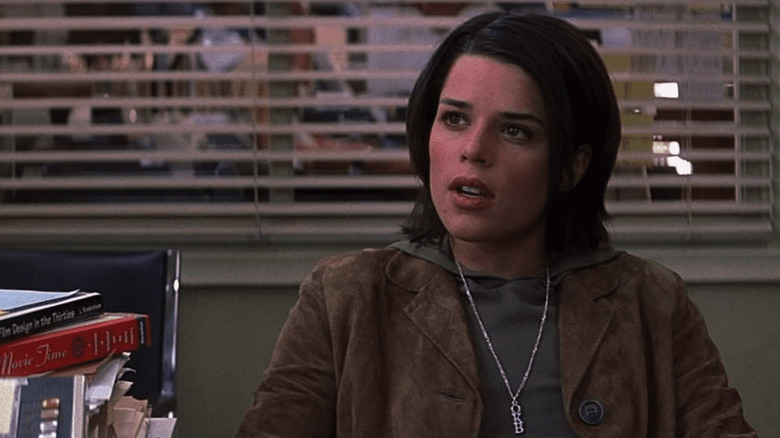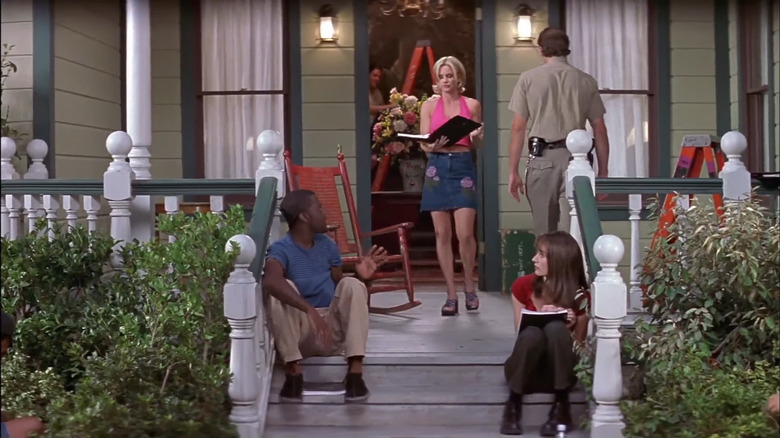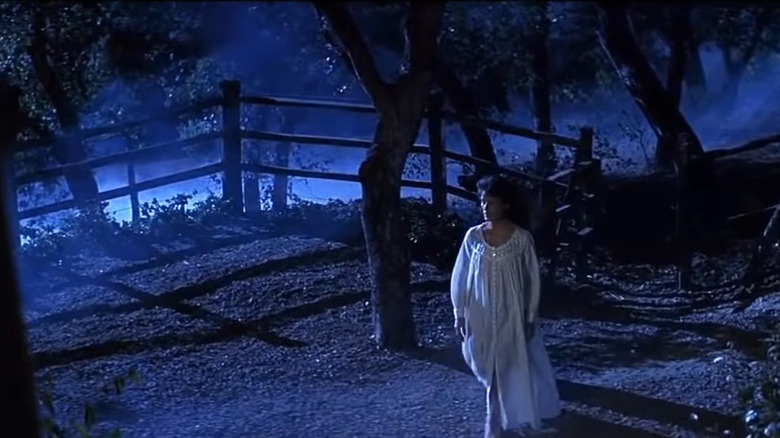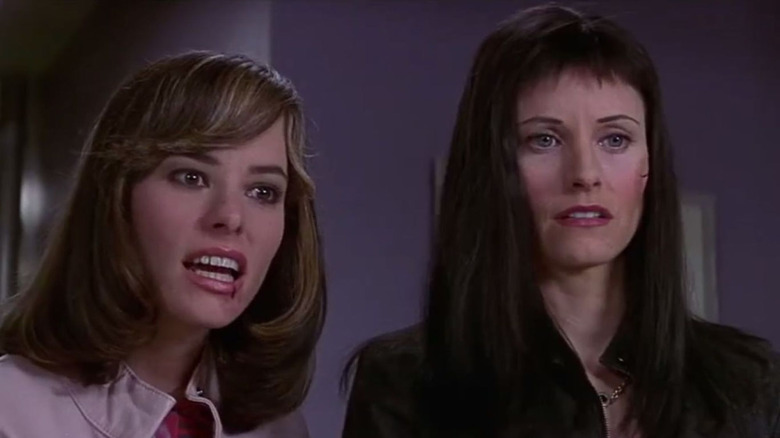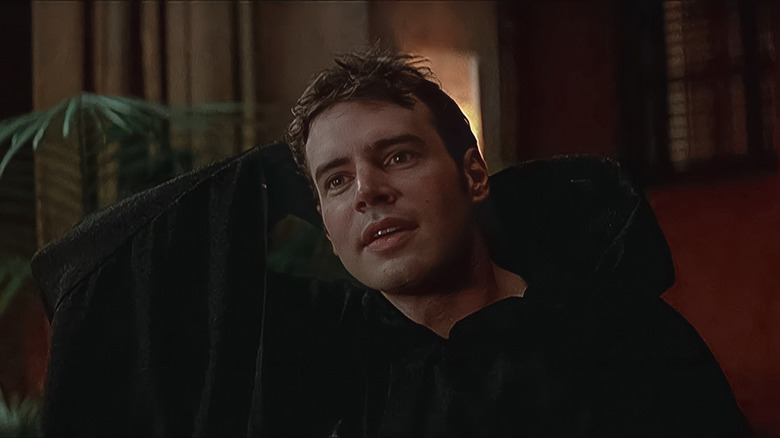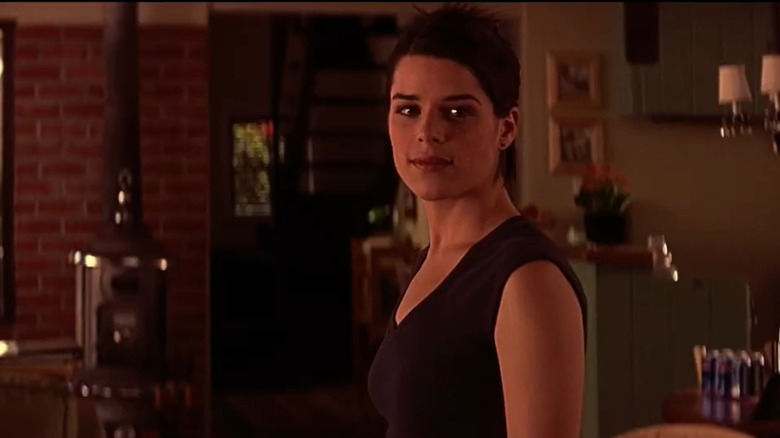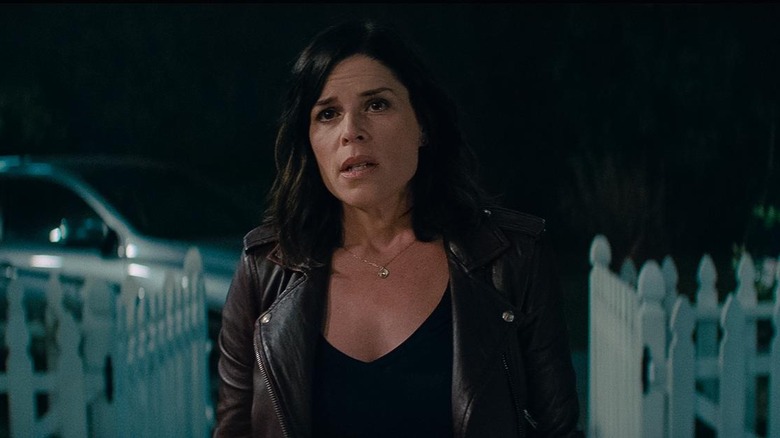Scream 3 Ending Explained: Sidney Gets The Closure She Needs
The biggest strength of the first three "Scream" films is the fact that they each follow the same core cast of characters. Each installment doesn't just give us a new mystery; it also reintroduces us to Sidney Prescott (Neve Campbell), Gale Weathers (Courteney Cox) and Dewey Riley (David Arquette), who must once again have their lives upended by a new knife-wielding psychopath (or pair of psychopaths).
Over the course of the original trilogy, we watch as Dewey finds his confidence and Gale learns to be less self-centered. It's Sidney, however, who has the strongest, most consistent arc throughout the trilogy. As she transforms from a normal teenager to a hardened survivor, her trauma over her experiences is treated with surprising sincerity and thoughtfulness. Billy Loomis' (Skeet Ulrich) betrayal in the first movie led to her having serious trust issues with her boyfriend Derek (Jerry O'Connell) in the second movie, which the killer took full advantage of. Perhaps more than anything, it's Derek's dying words at the end of "Scream 2" — "I never would've hurt you" — that truly broke her, to the point where by the beginning of "Scream 3" she's long since given up on trying to live a normal life.
At its core, "Scream 3" is a film about Sidney learning to move on from the events of the first two films. The movie succeeds at this character arc, but in doing so, it leads to a "Scream" film with perhaps the strangest tone and most disjointed pacing. It feels undeniably different from the rest of the series, but by the time it ends, it becomes clear that this isn't necessarily a bad thing.
A new cast of victims
Even the fiercest "Scream 3" defenders will acknowledge that the movie is less scary than the first two, and there are plenty of reasons why. In the aftermath of the Columbine shooting, and the wider cultural debate over the influence movie violence has over real life, "Scream 3" was under a lot of pressure to tone the bloodshed down. Sure enough, there's barely any blood in this film, and the kill sequences are missing most of the suspense we've gotten used to.
However, maybe the biggest reason why this movie isn't quite as scary is because the victims aren't people we care about. In the first two films, the group of people being stalked and killed were largely Sidney's friends and acquaintances, whereas here it's all underwritten Hollywood actors, many of whom Sidney never even meets. The only previously-established character killed off here is Cotton (Liev Schreiber), who's never been too sympathetic either. He spent most of "Scream 2" as a top suspect, and even when he saved Sidney's life at the end, it wasn't for the purest of reasons.
So for the first time in the series, Sidney makes it through the whole movie without suffering any major losses. Even the hardest-hitting death in the movie, Jennifer's (Parker Posey), happens when Sidney's still nowhere around. It can be frustrating that Sidney's not on screen for long stretches of the film, but it's a choice that makes sense: this is a movie about how Sidney learns to heal, and she can't do that if the victims are all her friends again.
Sidney, self-isolated
For the first half of the film, Sidney leads an isolated existence in the middle of nowhere, going by the name Laura and working at a women's crisis counseling hotline. She has multiple locks on her door and a home security system — she seems perfectly content never to meet a new person again. After all, the last two movies taught her some lessons that seem hard to argue with: every person she meets can either betray Sidney or be killed because of her. It's best for everyone, she figures, if she simply removes herself from society.
Of course, this doesn't last, and even if the killer hadn't tracked her down, it's likely she wouldn't have stayed in that house for long. The problem with isolating yourself in a house in the middle of nowhere is that, well, you're now alone in a house in the middle of nowhere. Even if you've made no new friends who can potentially kill you, you still have to deal with those occasional random noises you hear in the other room. The noises are probably nothing, but for someone with Sidney's kind of PTSD, they can turn being home alone at night into a living nightmare.
Speaking of nightmares, Sidney has one about her dead mother showing up outside her window, and its unlikely this is the first time she's had such a dream. Just see how creepy the woods around her house look at night: how could Sidney not have nightmares about seeing an ominous figure in the trees? Sidney may think she's keeping herself safe by living alone here, but all she's really doing is wallowing in her trauma, letting it fully take over her life because that's easier than healing.
Sidney begins to move on
When Sidney shows up at a police station in L.A. after the new Ghostface makes his first move, the background music is surprisingly whimsical, like something out of "E.T." You'd think her appearance would be accompanied by ominous music, as we know she's now in just as much danger as the rest of the cast. The fact that this moment instead plays as happy indicates exactly how different this film is from the first two, and why: this is not a movie about Sidney being hunted down against her will, but about Sidney making an active choice to help hunt down the killer herself.
Part of why "Scream 3" isn't as scary as the first two is because, by this point, Sidney's almost as much of a threat to the killer as he is to her. She's learned every lesson there is to learn from the first two movies, so by the time she's forced to rescue Dewey and Gale on her own, she can handle herself just fine. Like the killer, Sidney has the foresight to wear a bulletproof vest. Unlike the killer, she's smart enough to bring a second gun with her, giving Ghostface a false sense of security when his metal detector picks up the first one.
The most obvious example of Sidney's growth, of course, is her final battle with the killer. Throughout this whole confrontation, Sidney's consistently angry and calculating, not scared, and she holds her own absurdly well compared to anyone else in this series. Maybe the best moment is when she coldly cuts through all of Roman's excuses, telling him to "take some f***ing responsibility" before the argument descends into an all-out brawl, one in which Sidney certainly holds her own.
Roman vs. Sidney
Roman is often ranked low on the list of the franchise's killers, for understandable reasons. The voice-imitating technology he uses is a little too sci-fi for this series, and the movie itself doesn't play around with the device enough either. The reveal that he's responsible for Sidney's mother's death is also a little difficult to swallow. It feels more like a retcon than a natural continuation of the first movie's story. But of all the killers in the series (except maybe Jill), Roman's motives fit the most neatly into the movie's larger themes.
Roman is essentially a mirror of Sidney; he shows us what happens to people who dwell too long on their past. Roman reveals that he's Maureen's long-lost son, and he was devastated when he first tracked down Maureen and she rejected him. Being shut out cold from your mother is a legitimately painful experience, but Roman doesn't pick a healthy coping mechanism. Instead of moving on, he chooses to plot Maureen's murder, and he then spends years planning a killing spree centered around Sidney. Why does he want to kill Sidney? Because he's jealous that she got the love from Maureen that he never got.
This is part of why Sidney holds Roman's hand as he dies, a kind gesture that she never extends to any of the killers in the series. It's not just because he's her half brother, but because she understands him. At least, she understands the part about Roman's inability to let go of his pain. Sidney's in no danger of turning into a serial killer, of course, but here she's fully accepted the fact that dwelling on her painful past will only lead her to further misery. As impossible as it seems, she needs to move on.
Ending Sidney's story
The final scene of Sidney leaving her front door open is pretty straightforward: she's let go of her paranoia, and has returned to living a normal life where she doesn't expect a killer to pop out of every corner. It's a little silly if you think about it — killers won't get into the house but bugs still can, Sid! — but thematically it's a nice moment.
What's particularly nice, though, is the way the "Scream" franchise has stuck to this ending. After "Scream 3," the new tension for Sidney in these movies is no longer "will she die?" but rather, "Can she keep this new group of survivors safe?" Sidney may still end up going through the ringer by the end of "Scream 4," but there's no doubt while watching that she'll make it out just fine. Jill's (Emma Roberts) betrayal may sting, but Sidney's survived much worse.
This trend continues even in the upcoming sixth movie, where Sidney isn't in the story at all. Even before a pay dispute led Neve Campbell to walk away from the franchise entirely, it seemed like her character's role was already much smaller than it had ever been in the previous installments. Why? Because Sidney is so powerful by this point that she'd basically break the plot if she was a major presence. These are supposed to be horror movies, but we're rarely afraid anymore when Sidney's on screen, because we know beyond a doubt that she can handle herself.
It's time to let her go
The other reason for Sidney's lack of presence in the later films is because, well, her story was finished in "Scream 3." She found peace at the end of that film, and that peace has meaningfully lasted. Since then, she's enjoyed 20+ years of happiness, and the two brief interruptions in "Scream 4" and "5" haven't changed that.
Although many fans want Sidney to remain the main face of the franchise forever, "Scream 3" should've made it clear why this is not a smart option. Because Sidney has toughened up so much over the series (and so have Dewey and Gale, for that matter), "Scream 3" is by necessity more of an action thriller than a horror thriller. It's the sort of decision that works for a final movie dedicated to saying farewell to Sidney, but it's not a good long-term direction for a franchise that should at its core be horror. The "Scream" movies are supposed to scare us, and in 2023 they can only really do this by focusing on newer, less-hardened characters. It helps that, unlike Sidney, these new characters haven't yet become iconic to the point where we'd know the writers wouldn't dare kill them off.
For all of the third film's flaws, it did give us an emotional, uplifting finale to Sidney's story, and the franchise has been smart enough to not mess with it ever since. Even beyond the question of tone, Sidney shouldn't be the main character of these movies again, because to do so would risk undoing what this movie beautifully pulled off. After seeing how hard Sidney struggled to recover from the first two films, why would we ever want to risk messing all of that up?
